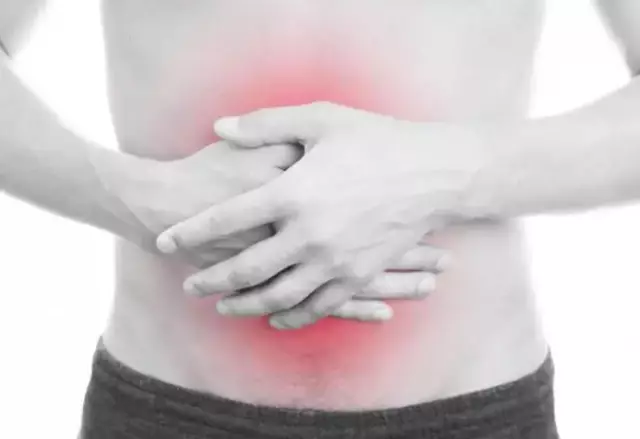- Author Rachel Wainwright [email protected].
- Public 2023-12-15 07:39.
- Last modified 2025-11-02 20:14.
Geographic language
The content of the article:
- Reasons for geographic language
- Forms
- Symptoms
- Features of the course of desquamative glossitis in children
- Diagnostics
- Geographic tongue treatment
- Prevention
- Consequences and complications
Geographic tongue (desquamative glossitis) is an inflammation of the mucous membrane of the tongue, accompanied by a violation of the processes of keratinization of the epithelial tissue and dystrophic changes in the papillae. On the back and lateral surfaces of the tongue, bright pink or red foci of desquamation of the epithelium appear framed by a light rim of exfoliated tissues, similar to the contours of the islands on the map. Hence the popular name of pathology - geographic language. According to WHO statistics, some manifestations of desquamative glossitis are observed in 2% of the population of developed countries.

Source: createsmile.ru
Reasons for geographic language
In medical science, there is no consensus regarding the etiology of desquamative glossitis. Geographic language is accompanied by a number of pathologies, among which the most common are:
- chronic diseases of the gastrointestinal tract, liver, kidneys and pancreas;
- vegetative-endocrine disorders;
- anemia and vitamin deficiency;
- helminthiasis;
- collagenosis (geographic tongue is observed in 16-42% of patients with rheumatism and systemic lupus erythematosus);
- diseases of the hematopoietic organs, especially the spleen;
- intestinal dysbiosis against the background of prolonged use of antibiotics;
- allergic and atopic conditions;
- acute infectious processes.
In about half of the cases, desquamative glossitis is accompanied by a folded tongue, a congenital anomaly characterized by hypertrophy of the muscles of the tongue and the formation of deep longitudinal and transverse folds in it. Also, a connection has been established between desquamation processes and fluctuations in hormonal status: the geographical language in adult women is more common than in men, and most of the visits to a doctor about this occur during pregnancy or menopause.
Forms
Depending on the depth and localization of mucosal defects, the picture of the geographical language appears in two varieties - fixed and migratory. With a fixed form, pathological foci are localized in the same places, with migrating areas of desquamation and zones of hyperkeratosis change places.
Migrating desquamative glossitis manifests itself either superficially in the form of erythema, or in an erosive-ulcerative form, which is characterized by ulceration and extensive drainage defects of the mucous membrane of the tongue.
An alternative classification identifies three characteristic manifestations of the geographical language, based on the nature of the changes in the epithelium:
- superficial - areas of erythema and desquamation of the epithelium have clear boundaries, violation of keratinization of the papillae is expressed moderately or completely absent; the color of the mucous membrane around the lesions does not change;
- hyperplastic - the formation of zones of desquamation of the epithelium is accompanied by the compaction of the filiform papillae of the tongue and the appearance of light-colored areas of hyperkeratosis around the pathological foci;
- lichenoid - the formation of extensive asymmetric foci of desquamation with a simultaneous increase and compaction of the papillae of the tongue. The lichenoid form of desquamative glossitis usually develops against a background of neuroendocrine disorders or is a manifestation of an allergic reaction to metal dentures or lauryl sulfates in toothpastes and gum rinses.
Symptoms
The clinical picture of desquamative glossitis develops gradually. First, a small focus of scaly peeling of a white-gray shade with a diameter of several millimeters appears on the back or on one of the lateral surfaces of the tongue, which quickly increases, swells and becomes crimson, and a raised border of clouded desquamated epithelium forms along its edges. Occasionally, desquamation sites are found on the mucous membrane of the cheeks, gums and palate.
Inside the foci, enlarged papillae are clearly visible, similar to bright red dots. The areas of desquamation of the epithelium, as a rule, have a rounded shape, while the desquamation zones resemble rings, half rings or asymmetric spots in outline; with a significant increase in the desquamation zones, the boundaries of pathological foci may blur. With a migratory form, normal keratinization of the papillae is restored in the center of the focus, and active desquamation of the epithelium begins in the peripheral areas of desquamation, as a result of which the affected areas change places. Thus, the geographical pattern on the mucous membranes of the tongue can change within a day.
With a prolonged course of desquamative glossitis, the tongue softens and increases in size; patients may complain of burning and tingling of the tongue, distortion of taste perception or complete loss of taste, an unpleasant taste in the mouth, impaired articulation, difficulty swallowing and painful sensations while taking hot, sour, spicy and salty foods, strong alcohol and other irritating drinks. With a relapse of the underlying disease, the discomfort from the geographical language increases.
Features of the course of desquamative glossitis in children
Geographic language is more common in children than in adults. The most common causes of geographic language in childhood are exudative diathesis and helminthic invasion, however, moderate manifestations of desquamative glossitis can also be present against the background of complete well-being as a variant of the individual norm.

Source: schoowell.jp
Geographic language is generally not uncomfortable for children. Episodic exacerbations self-resolve within a few weeks; as the child grows up, the manifestations of desquamative glossitis, which are not accompanied by systemic diseases, can completely disappear.
In some cases, a child's geographical language is observed on the basis of age-related changes - during teething or during puberty. In adolescent girls, flare-ups are common before menstruation.
Diagnostics
Geographic tongue is usually diagnosed incidentally during oral examinations with a dentist, therapist, pediatrician, and other professionals. To identify concomitant pathologies, laboratory tests are carried out - general blood and urine tests, biochemical blood tests, feces analysis for helminth eggs. If somatic pathologies are suspected, consultations of appropriate specialists and instrumental examinations of internal organs and functional systems are prescribed.
Geographic tongue treatment
In the absence of complaints, desquamative glossitis does not need special treatment. In case of painful sensations, oral cavity sanitation is recommended. When discomfort occurs during a conversation and eating, local symptomatic agents are used to treat the geographical tongue - antiseptic rinsing, irrigation and oral baths, applications of keratoplastic and anesthetic agents, preparations of fat-soluble vitamins A and E and water-soluble B vitamins, which accelerate the epithelialization of the tongue defect … With severe pain, they resort to novocaine blockade of the trigeminal nerve.
Prevention
Due to the unclear etiology of the pathological process, it is not yet possible to prevent the occurrence of desquamative glossitis. In order to prevent relapses, it is important to promptly identify and treat somatic and dental diseases, adhere to a balanced diet and organize thorough oral care with the use of gentle and hypoallergenic hygiene products. It is recommended to floss and rinse your mouth with a disinfectant solution after every meal. With a combination of a geographic and a folded tongue, a professional sanitation of the oral cavity is required, since microbial plaque accumulates in the deep grooves of the mucous membrane, which provokes inflammation. With frequent exacerbations, the patient should exclude all irritating dishes from the menu and limit the consumption of instant carbohydrates;may be justified course intake of vitamin and mineral supplements stimulating epithelization action once every six months.
In order to avoid infection of children with helminths, it is important to teach them as early as possible to wash their hands before eating and after using the toilet, as well as to follow the rules of sanitary and culinary processing of products, and to deworm pets on time. Adults should give up smoking and drinking alcoholic beverages, do not save on high-quality dental prosthetics, and also avoid taking potent medicines and antibiotics without a doctor's prescription.
Consequences and complications
Periodic exacerbations of desquamative glossitis usually go away without serious consequences.
Possible complications are predominantly local in nature; these include the addition of a bacterial infection, the development of a secondary purulent-inflammatory process, damage to the submandibular lymph nodes and the formation of cracks in the damaged areas of the mucous membranes.
The prognosis for the patient's life is favorable; altered sections of the epithelium are not prone to malignant degeneration.
YouTube video related to the article:

Anna Kozlova Medical journalist About the author
Education: Rostov State Medical University, specialty "General Medicine".
The information is generalized and provided for informational purposes only. At the first sign of illness, see your doctor. Self-medication is hazardous to health!






